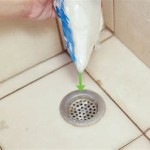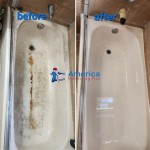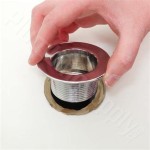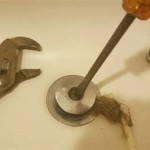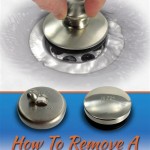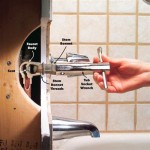How Does A Bathtub Overflow Plate Work?
The bathtub overflow plate, often overlooked yet crucial, is a component of a bathtub's drainage system designed to prevent flooding. Its primary function is to provide an escape route for excess water when the water level in the tub rises too high, typically due to a forgotten running faucet or an obstruction in the main drain. Understanding the mechanics of an overflow plate is essential for maintaining the functionality of a bathroom and preventing water damage.
The overflow plate is the visible component, typically a small, often decorative, plate situated near the top of the bathtub on the same side as the drain. Behind this plate lies a more complex mechanism that connects to the main drainpipe. This connection allows excess water to bypass the main drain stopper and flow directly into the drainage system, preventing water from spilling over the tub's edge.
The design and operation of a bathtub overflow plate involve several key principles. Firstly, it relies on gravity to redirect the excess water. Secondly, it involves a network of pipes and openings that must be clear and unobstructed to function correctly. Lastly, it integrates with the main drain system, ensuring that leaked water joins the existing wastewater flow without disrupting the normal drain operation.
Understanding the Components
The bathtub overflow system is composed of several interacting parts which work together to divert excess water. These include the overflow plate itself, the overflow pipe, the connecting pipe (or shoe), and, importantly, the linkage that may connect the overflow mechanism to the drain stopper.
The overflow plate is the visible, often chrome-plated, fixture. It’s typically held in place by one or two screws. Removing the plate allows access to the internal mechanisms. Behind the plate is an opening, often circular or oval, which is the entry point for the overflow water. The size and shape of this opening are designed to allow a significant water flow to prevent rapid water level increases in the bathtub.
Connected to the opening behind the overflow plate is the overflow pipe. This is a vertical pipe, usually made of PVC or metal, that runs down the wall cavity behind the bathtub. The overflow pipe's primary function is to channel the water that enters through the overflow plate opening downwards towards the main drain.
At the bottom of the overflow pipe, it connects to the main drainpipe through a fitting often referred to as the "shoe". This connection is critical as it’s where the overflow water is integrated back into the main drainage system. The design of the shoe ensures that the overflow water joins the primary wastewater flow without causing any backflow or disruption.
In many bathtub designs, the overflow mechanism is linked to the drain stopper. This linkage, often consisting of a lever or a series of rods and pivots, allows the user to control the drain stopper by manipulating a lever or knob on the overflow plate. When the lever is moved, it lifts or lowers the drain stopper, opening or closing the main drain. This integrated system simplifies operation and reduces the number of visible controls on the bathtub.
Operational Mechanics of the Overflow System
The bathtub overflow system functions based on a simple principle: when the water level in the bathtub exceeds a certain point, the excess water enters the overflow opening behind the overflow plate. This water then flows down the overflow pipe and into the main drainpipe through the shoe connection. The entire process is driven by gravity and relies on clear, unobstructed pathways for the water to flow.
When the water level in the bathtub is below the overflow opening, the system remains inactive. The main drain handles all wastewater drainage. However, if the water level rises to or above the overflow opening, water begins to enter the system. The rate at which water enters the overflow system depends on the water level above the opening and the size of the opening itself. A larger opening will allow for a greater volume of water to be diverted, preventing the bathtub from overflowing more effectively.
As water flows down the overflow pipe, it’s crucial that the pipe is free from obstructions. Any blockage, such as hair, soap scum, or mineral buildup, can restrict the flow of water and reduce the system's effectiveness. Regular cleaning and maintenance are essential to ensure that the overflow pipe remains clear and functional.
The connection between the overflow pipe and the main drainpipe at the shoe is another critical point. The shoe is designed to allow the overflow water to merge seamlessly with the main wastewater flow. This connection must be properly sealed to prevent leaks into the wall cavity. A loose or damaged shoe can lead to significant water damage over time, necessitating costly repairs.
For overflow systems linked to the drain stopper mechanism, the movement of the lever or knob on the overflow plate directly affects the position of the drain stopper. When the lever is in the "open" position, the drain stopper is lifted, allowing water to flow freely down the main drain. When the lever is in the "closed" position, the drain stopper is lowered, sealing the drain and allowing the bathtub to fill with water. The linkage between the overflow mechanism and the drain stopper must be properly adjusted to ensure that the drain stopper seals tightly and that the overflow system functions correctly.
Troubleshooting Common Issues
Several common issues can compromise the functionality of a bathtub overflow system. These issues typically involve blockages, leaks, or problems with the drain stopper linkage. Regular inspection and maintenance can help to identify and resolve these issues before they lead to more significant problems.
Blockages are a common cause of overflow system malfunctions. Hair, soap scum, and mineral deposits can accumulate in the overflow pipe and restrict the flow of water. If the overflow system is not draining properly, the first step is to check for blockages. This can be done by removing the overflow plate and using a small tool, such as a bent wire or a specialized drain cleaning tool, to clear any obstructions in the overflow pipe. Flushing the pipe with hot water can also help to dislodge debris.
Leaks in the overflow system can occur at several points, including the connection between the overflow plate and the bathtub, the joints in the overflow pipe, and the connection at the shoe. Leaks are often caused by worn-out seals or loose connections. To check for leaks, carefully inspect all visible parts of the overflow system while the bathtub is filling with water. If a leak is detected, tighten any loose connections or replace any damaged seals. In some cases, it may be necessary to disassemble the overflow system to properly repair a leak.
Problems with the drain stopper linkage can also affect the overflow system's functionality. If the drain stopper is not sealing properly, water may leak out of the bathtub even when the stopper is in the "closed" position. This can be caused by a misaligned or damaged linkage. To adjust the drain stopper linkage, remove the overflow plate and inspect the mechanism. Use a screwdriver or pliers to adjust the linkage until the drain stopper seals tightly. If the linkage is damaged, it may need to be replaced.
Another potential issue is a corroded or damaged overflow pipe. Over time, exposure to water and humidity can cause the overflow pipe to corrode, leading to leaks or structural failure. If the overflow pipe is severely corroded, it should be replaced. This typically involves removing the bathtub surround to access the pipe and replacing it with a new one. It's important to use the same type of pipe and fittings to ensure a proper fit and prevent leaks.
Preventative maintenance is key to keeping the bathtub overflow system functioning correctly. Regularly clean the overflow plate and pipe to prevent blockages. Inspect the system for leaks and address any issues promptly. Ensure that the drain stopper linkage is properly adjusted. By taking these steps, one can prevent costly repairs and keep the bathroom functioning smoothly.

Bathroom Fixtures How Do You Turn The Overfow Drain In Tub Upside Down Home Improvement Stack Exchange

Drain Overflow Assemblies Fine Homebuilding

How To Install A New Bathtub Overflow Plate Assembly

What Is A Bathtub Overflow Drain 2025 Guide With Examples And Photos Badeloft

What Is A Bathtub Overflow Drain 2025 Guide With Examples And Photos Badeloft
What Is The Purpose Of A Sink And Tub Overflow Drain Signature Hardware

What Is A Bathtub Overflow Drain Does All Tubs Have
What Is The Purpose Of A Sink And Tub Overflow Drain Signature Hardware

How To Fix A Leaking Bathtub Overflow Drain Diy Guide

How To Replace A Bathtub Drain

